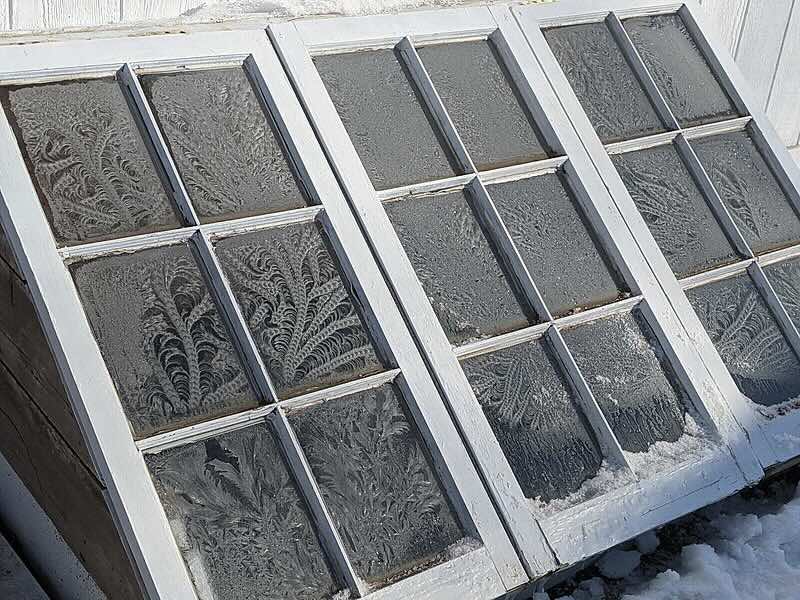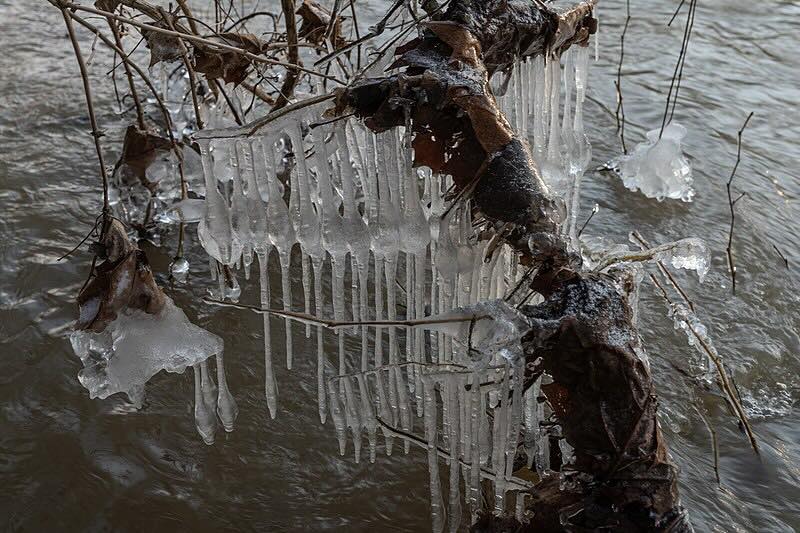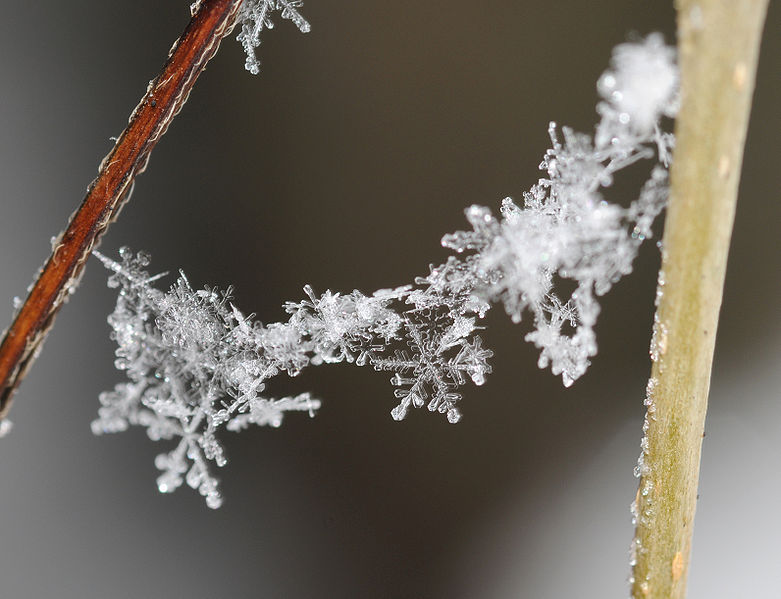เมื่อฤดูหนาวมาถึง โลกจะเปลี่ยนเป็นดินแดนมหัศจรรย์ที่ปกคลุมไปด้วยหิมะและน้ำค้างแข็งที่ส่องประกาย แต่คุณเคยสงสัยเกี่ยวกับวิทยาศาสตร์เบื้องหลังปรากฏการณ์ฤดูหนาวที่น่าหลงใหลเหล่านี้หรือไม่? ในโพสต์บล็อกนี้ เราจะเจาะลึกเข้าไปในโลกที่น่าทึ่งของหิมะ น้ำค้างแข็ง และน้ำแข็ง เพื่อค้นหากระบวนการทางวิทยาศาสตร์ที่สร้างสิ่งมหัศจรรย์ในฤดูหนาวเหล่านี้
น้ำค้างแข็ง: งานศิลปะที่ละเอียดอ่อนของธรรมชาติ
 ที่มาของภาพ: Skiba, Justin M., CC BY-SA 4.0, ผ่าน Wikimedia Commons
ที่มาของภาพ: Skiba, Justin M., CC BY-SA 4.0, ผ่าน Wikimedia Commons
ในเช้าวันฤดูหนาวที่หนาวเย็น เรามักจะเห็นรูปแบบน้ำค้างแข็งที่ซับซ้อนถูกสลักไว้อย่างละเอียดบนหน้าต่างและใบไม้ น้ำค้างแข็งก่อตัวขึ้นผ่านกระบวนการที่เรียกว่าการสะสม เมื่ออากาศมีความชื้นและอุณหภูมิลดลงต่ำกว่าจุดเยือกแข็ง ไอน้ำจะเปลี่ยนจากก๊าซเป็นของแข็งโดยตรง ก่อตัวเป็นน้ำค้างแข็งบนพื้นผิว รูปแบบที่เป็นเอกลักษณ์ที่เราเห็นเป็นผลมาจากปฏิสัมพันธ์ระหว่างระดับความชื้น ลักษณะพื้นผิว และระยะเวลาของอุณหภูมิที่เยือกแข็ง
นี่คือคำอธิบายทีละขั้นตอนเกี่ยวกับวิธีการก่อตัวของรูปแบบน้ำค้างแข็ง:
- พื้นผิวเย็น รูปแบบน้ำค้างแข็งต้องการพื้นผิวเย็นเพื่อก่อตัว
- ความชื้นในอากาศ อากาศรอบตัวเรามีไอน้ำในรูปของหยดน้ำเล็กๆ ความชื้นนี้สามารถมาจากแหล่งต่างๆ รวมถึงความชื้นในอาคาร การหายใจ การทำอาหาร หรือความชื้นภายนอกในอากาศ
- ความแตกต่างของอุณหภูมิ อุณหภูมิของพื้นผิวต่ำกว่าจุดน้ำค้างของอากาศ จุดน้ำค้างคืออุณหภูมิที่อากาศอิ่มตัวด้วยความชื้นและไม่สามารถกักเก็บไอได้อีกต่อไป เมื่ออากาศใกล้หน้าต่างเย็นลงถึงอุณหภูมิหรือจุดน้ำค้าง จะถึงสภาวะอิ่มตัว ส่งผลให้ความชื้นส่วนเกินเริ่มควบแน่น
- การควบแน่น ความชื้นในอากาศควบแน่นเป็นหยดน้ำหรือผลึกน้ำแข็งเล็กๆ บนพื้นผิวเย็น ซึ่งคล้ายกับวิธีที่น้ำค้างก่อตัวบนหญ้าและพื้นผิวอื่นๆ กลางแจ้งในตอนเช้าตรู่เมื่ออุณหภูมิลดลง
- การเจริญเติบโตของผลึกน้ำแข็ง เมื่อการควบแน่นเริ่มขึ้น รูปแบบน้ำค้างแข็งสามารถเติบโตต่อไปได้ รูปร่างและขนาดของผลึกน้ำค้างแข็งขึ้นอยู่กับปัจจัยต่างๆ ปัจจัยเหล่านี้รวมถึงความลาดชันของอุณหภูมิข้ามหน้าต่าง ความชื้นในอากาศ และสิ่งสกปรกหรือความไม่สม่ำเสมอบนพื้นผิว
- การก่อตัวของรูปแบบ รูปแบบน้ำค้างแข็งมักปรากฏในดีไซน์ที่ซับซ้อนและสวยงาม เนื่องจากความไม่สมบูรณ์และความไม่สม่ำเสมอในระดับจุลภาคบนพื้นผิวมีอิทธิพลต่อจุดควบแน่นเริ่มต้นและการก่อตัวของผลึกหิมะในภายหลัง รูปแบบเหล่านี้สามารถมีรูปแบบต่างๆ เช่น รูปแบบคล้ายเฟิร์น น้ำค้างแข็งเป็นขนนก หรือผลึกน้ำแข็งธรรมดา
วิทยาศาสตร์ของการก่อตัวของน้ำแข็ง
 ที่มาของภาพ: Matthew.kowal, CC BY-SA 4.0, ผ่าน Wikimedia Commons
ที่มาของภาพ: Matthew.kowal, CC BY-SA 4.0, ผ่าน Wikimedia Commons
จากบ่อน้ำที่กลายเป็นน้ำแข็งไปจนถึงน้ำแข็งที่ห้อยลงมาจากหลังคา น้ำแข็งเป็นสิ่งที่พบเห็นได้ทั่วไปในฤดูหนาว การทำความเข้าใจกระบวนการก่อตัวของน้ำแข็งมีความสำคัญทั้งในด้านปฏิบัติและวิทยาศาสตร์ เมื่ออุณหภูมิของน้ำลดลงต่ำกว่าจุดเยือกแข็ง โมเลกุลของน้ำจะเคลื่อนที่ช้าลงและจัดเรียงตัวเองเป็นโครงสร้างผลึกปกติ ก่อตัวเป็นน้ำแข็ง กระบวนการก่อตัวของน้ำแข็งประกอบด้วยขั้นตอนสำคัญหลายประการ:
- การทำให้เย็นลง ขั้นแรก สารจะเย็นลงต่ำกว่าจุดเยือกแข็ง นี่คืออุณหภูมิที่เปลี่ยนจากของเหลวเป็นของแข็ง: 32°F หรือ 0°C เมื่ออุณหภูมิลดลง โมเลกุลของของเหลวจะเคลื่อนที่ช้าลงและมีพลังงานน้อยลง
- การเกิดนิวเคลียส ผลึกน้ำแข็งขนาดเล็กที่เรียกว่านิวเคลียสของน้ำแข็งหรือเมล็ดน้ำแข็งก่อตัวขึ้น พวกมันก่อตัวขึ้นเองหรือด้วยความช่วยเหลือของสิ่งสกปรกหรือพื้นผิวที่ช่วยให้น้ำแข็งเติบโต ในสภาพน้ำที่สะอาด การเกิดนิวเคลียสอาจยากขึ้นเพราะต้องการพลังงานมากขึ้น
- การเจริญเติบโต โมเลกุลของของเหลวเข้าร่วมกับผลึกน้ำแข็งเมื่อพวกมันแข็งตัว ผลึกน้ำแข็งจะใหญ่ขึ้นเมื่อมีโมเลกุลของเหลวเข้าร่วมมากขึ้น
- การให้ความร้อน โมเลกุลของของเหลวสูญเสียพลังงานบางส่วนเมื่อพวกมันแข็งตัว พลังงานนี้จะออกมาเป็นความร้อน (เรียกว่าความร้อนแฝงของการหลอมเหลว) นี่คือเหตุผลที่คุณรู้สึกอุ่นเมื่อสัมผัสน้ำแข็งขณะที่มันละลายในมือคุณ
- การแพร่กระจาย น้ำจะขยายตัวเมื่อมันแข็งตัว นี่เป็นเพราะวิธีที่โมเลกุลของน้ำเรียงตัวกันในผลึก
- การแช่แข็ง ของเหลวทั้งหมดเปลี่ยนเป็นของแข็ง ก่อตัวเป็นน้ำแข็ง
คุณควรรู้ด้วยว่าจุดเยือกแข็งของสารสามารถเปลี่ยนแปลงได้ขึ้นอยู่กับความดันและสิ่งอื่นๆ ในสารนั้น ตัวอย่างเช่น การใส่เกลือลงในน้ำทำให้มันแข็งตัวที่อุณหภูมิต่ำกว่า ซึ่งเป็นเหตุผลว่าทำไมเกลือจึงถูกใช้ในการละลายน้ำแข็งบนถนน
ความมหัศจรรย์ของเกล็ดหิมะ
 ที่มาของภาพ: Thomas Bresson, CC BY 2.0, ผ่าน Wikimedia Commons
ที่มาของภาพ: Thomas Bresson, CC BY 2.0, ผ่าน Wikimedia Commons
ไม่มีเกล็ดหิมะสองเกล็ดที่เหมือนกัน และความเป็นเอกลักษณ์นี้เป็นผลมาจากกระบวนการที่ซับซ้อนที่เกิดขึ้นในเมฆ การก่อตัวของเกล็ดหิมะเกิดขึ้นเมื่อหยดน้ำที่เย็นจัดแข็งตัวรอบๆ อนุภาคฝุ่นเล็กๆ ในบรรยากาศ สร้างผลึกน้ำแข็ง เมื่อผลึกน้ำแข็งเหล่านี้ขึ้นและลงภายในเมฆ พวกมันจะเก็บไอน้ำมากขึ้นและเติบโตขึ้น โดยพัฒนาโครงสร้างหกเหลี่ยมที่มีหกด้าน รูปร่างที่แน่นอนของเกล็ดหิมะขึ้นอยู่กับอุณหภูมิและสภาพความชื้นในระหว่างการก่อตัว ส่งผลให้เกิดรูปแบบเกล็ดหิมะที่หลากหลายอย่างน่าทึ่ง
นี่คือวิธีการสร้างเกล็ดหิมะ:
- ไอน้ำในอากาศ เกล็ดหิมะเริ่มต้นด้วยไอน้ำในอากาศ
- การทำให้เย็นลง ขั้นตอนต่อไปคือการทำให้อากาศเย็นลง สิ่งนี้สามารถเกิดขึ้นได้หลายวิธี เช่น อากาศขึ้น อากาศสูญเสียความร้อน หรืออากาศสัมผัสกับสิ่งที่เย็น (เช่น พื้นดินในฤดูหนาว) เมื่ออากาศเย็นลง มันไม่สามารถกักเก็บไอน้ำได้มากเท่าเดิม
- การเกิดนิวเคลียส ในการสร้างเกล็ดหิมะ คุณต้องมีนิวเคลียสของน้ำแข็งขนาดเล็กหรือผลึกเมล็ด สิ่งเหล่านี้สามารถมาจากแหล่งต่างๆ บางครั้งสิ่งสกปรก ชิ้นน้ำแข็งเล็กๆ หรือสิ่งอื่นๆ ในอากาศทำหน้าที่เป็นนิวเคลียส หยดน้ำที่แช่แข็งหรือเย็นจัดอยู่แล้วก็สามารถกลายเป็นนิวเคลียสได้เช่นกัน
- การเจริญเติบโต โมเลกุลของไอน้ำในอากาศเกาะติดกับนิวเคลียสและแข็งตัว ผลึกน้ำแข็งจะใหญ่ขึ้นเมื่อมีโมเลกุลของไอน้ำเข้าร่วมมากขึ้น สิ่งนี้ขึ้นอยู่กับอุณหภูมิเป็นอย่างมากและเกิดขึ้นในรูปทรงหกด้าน นั่นคือเหตุผลที่เกล็ดหิมะมีหกด้าน
- การแตกแขนงและการสร้างรูปร่าง เมื่อผลึกน้ำแข็งใหญ่ขึ้น มันจะเติบโตเป็นกิ่งก้านหรือแขนลักษณะของเกล็ดหิมะขึ้นอยู่กับอุณหภูมิ ความชื้น และสภาพบรรยากาศอื่นๆ รูปแบบที่สวยงามและสมมาตรของเกล็ดหิมะเกิดจากวิธีพิเศษที่โมเลกุลของน้ำเรียงตัวกันในผลึก
- การเกาะติดกัน บางครั้งเกล็ดหิมะชนกับผลึกน้ำแข็งอื่นๆ ในอากาศและรวมตัวกัน สิ่งนี้สามารถสร้างเกล็ดหิมะที่ใหญ่ขึ้นและซับซ้อนมากขึ้น
- การตกลง เมื่อเกล็ดหิมะมีขนาดใหญ่และหนักพอ มันจะตกลงสู่พื้นเป็นหิมะ
บทสรุป
สภาพอากาศในฤดูหนาวเป็นการแสดงที่น่าทึ่งของความซับซ้อนและความงามของธรรมชาติ จากรูปแบบน้ำค้างแข็งไปจนถึงการก่อตัวของผลึกน้ำแข็ง เราได้สำรวจวิทยาศาสตร์เบื้องหลังปรากฏการณ์ฤดูหนาวเหล่านี้ นี่คือตารางสรุปการก่อตัวของสิ่งมหัศจรรย์ในฤดูหนาวเหล่านี้รวมถึงปัจจัยที่มีอิทธิพลต่อการก่อตัวนี้:
| ปรากฏการณ์ | กระบวนการก่อตัว | ปัจจัยที่มีอิทธิพล |
|---|---|---|
| น้ำค้างแข็ง | การสะสม (ความชื้นในอากาศ, การลดลงของอุณหภูมิ) | ลักษณะพื้นผิว, ความลาดชันของอุณหภูมิ |
| น้ำแข็ง | การทำให้เย็นลง, การเกิดนิวเคลียส, การเจริญเติบโต, การแพร่กระจาย | สิ่งสกปรก, ความดัน, ความร้อนแฝงของการหลอมเหลว |
| เกล็ดหิมะ | การทำให้เย็นลง, การเกิดนิวเคลียส, การเจริญเติบโต, การแตกแขนง | อุณหภูมิ, ความชื้น, สภาพบรรยากาศ |
น้ำค้างแข็ง น้ำแข็ง และเกล็ดหิมะมีวิทยาศาสตร์ที่น่าทึ่งอยู่เบื้องหลัง ช่วยให้เราสนุกกับฤดูหนาวได้มากขึ้น ขอให้ปลอดภัยและอบอุ่นในช่วงเวลาที่วิเศษนี้ของปี ```






